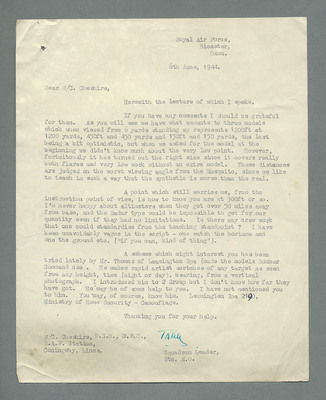Letter to Leonard Cheshire from Squadron Leader T Kell
Title
Letter to Leonard Cheshire from Squadron Leader T Kell
Description
Recounts a lecture using models of targets which when viewed from 6 yards represent various sizes at various distances. Problem is to know accurately what height you are.
Creator
Date
1944-06-06
Temporal Coverage
Language
Format
One-page typewritten letter
Is Part Of
Publisher
Rights
This content is property of the Leonard Cheshire Archive which has kindly granted the International Bomber Command Centre Digital Archive a royalty-free permission to publish it. Please note that it was digitised by a third-party which used technical specifications that may differ from those used by International Bomber Command Centre Digital Archive. It has been published here ‘as is’ and may contain inaccuracies or culturally inappropriate references that do not necessarily reflect the official policy or position of the University of Lincoln or the International Bomber Command Centre.
Contributor
Identifier
SCheshireGL72021v10069
Transcription
Royal Air Force,
Bicester,
Oxon.
6th June, 1944.
Dear W/C. Cheshire,
Herewith the lecture of which I spoke.
If you have any comments I should be grateful for them. As you will see we have what amounts to three models which viewed from 6 yards standing up represents 1200ft at 1200 yards, 450 ft and 450 yards and 150 ft and 150 yards, the last being a bit optimistic, but when we asked for the model at the beginning we didn't know much about the very low point. However, fortuitously it has turned out the right size since it covers really both flares and very low work without an extra model. These distances are judged on the worst viewing angle from the Mosquito, since we like to teach in such a way that the synthetic is worse than the real.
A point which still worries me, from the instruction point of view, is how to know you are at 300ft or so. I'm never happy about altimeters when they get over 50 miles away from base, and the Radar type would be impossible to get for our quantity even if they had no limitations. Is here any crew work that one could standardise from the teaching standpoint? I have been unavoidably vague in the script – one watch the horizon and one the ground etc. (“if you can, this kind of thing”).
A scheme which might interest you has been tried lately by Mr Thomas of Leamington Spa (made the models Bomber Command use. He makes rapid artist scetches[sic] of any target as seen from any height, time (night or day), bearing, from a vertical photograph. I introduced him to 2 Group but don't know how far they have got. He may be of some help to you. I have not mentioned you to him. You may, of course, know him. Leamington Spa 2190, Ministry of Home Security – Camouflage.
Thanking you for your help.
T. A.[?] Kell.
Squadron Leader,
Stn. M.O.
W/C. Cheshire, D.S.O., D.F.C.,
R.A.F. Station,
Coningsby, Lincs.
Bicester,
Oxon.
6th June, 1944.
Dear W/C. Cheshire,
Herewith the lecture of which I spoke.
If you have any comments I should be grateful for them. As you will see we have what amounts to three models which viewed from 6 yards standing up represents 1200ft at 1200 yards, 450 ft and 450 yards and 150 ft and 150 yards, the last being a bit optimistic, but when we asked for the model at the beginning we didn't know much about the very low point. However, fortuitously it has turned out the right size since it covers really both flares and very low work without an extra model. These distances are judged on the worst viewing angle from the Mosquito, since we like to teach in such a way that the synthetic is worse than the real.
A point which still worries me, from the instruction point of view, is how to know you are at 300ft or so. I'm never happy about altimeters when they get over 50 miles away from base, and the Radar type would be impossible to get for our quantity even if they had no limitations. Is here any crew work that one could standardise from the teaching standpoint? I have been unavoidably vague in the script – one watch the horizon and one the ground etc. (“if you can, this kind of thing”).
A scheme which might interest you has been tried lately by Mr Thomas of Leamington Spa (made the models Bomber Command use. He makes rapid artist scetches[sic] of any target as seen from any height, time (night or day), bearing, from a vertical photograph. I introduced him to 2 Group but don't know how far they have got. He may be of some help to you. I have not mentioned you to him. You may, of course, know him. Leamington Spa 2190, Ministry of Home Security – Camouflage.
Thanking you for your help.
T. A.[?] Kell.
Squadron Leader,
Stn. M.O.
W/C. Cheshire, D.S.O., D.F.C.,
R.A.F. Station,
Coningsby, Lincs.
Collection
Citation
T Kell, “Letter to Leonard Cheshire from Squadron Leader T Kell,” IBCC Digital Archive, accessed July 27, 2024, https://ibccdigitalarchive.lincoln.ac.uk/omeka/collections/document/16987.
Item Relations
This item has no relations.

